Themed collection Aquatic photochemistry

Themed issue on aquatic photochemistry
Guest editor Kris McNeill introduces this themed issue on Aquatic Photochemistry.

Environ. Sci.: Processes Impacts, 2014,16, 626-627
https://doi.org/10.1039/C4EM90009J
A critical assessment of the photodegradation of pharmaceuticals in aquatic environments: defining our current understanding and identifying knowledge gaps
A standardized scoring rubric provided critical assessment—positive and negative—of the state of knowledge of aquatic photochemistry of pharmaceuticals.
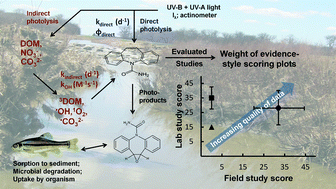
Environ. Sci.: Processes Impacts, 2014,16, 672-696
https://doi.org/10.1039/C3EM00615H
The importance of charge-transfer interactions in determining chromophoric dissolved organic matter (CDOM) optical and photochemical properties
A critical review presenting the case for an electronic interaction model as the basis for CDOM optical and photochemical properties.
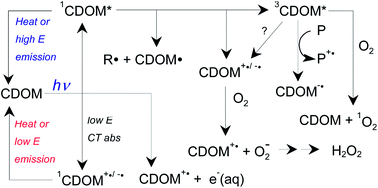
Environ. Sci.: Processes Impacts, 2014,16, 654-671
https://doi.org/10.1039/C3EM00573A
Photo-transformation of pharmaceutically active compounds in the aqueous environment: a review
This review summarizes the last 10 years (2003–2013) of studies on the solar or solar-simulated photodegradation of pharmaceutically active compounds (PhACs) in aqueous environments.
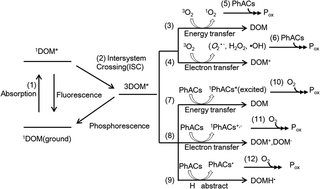
Environ. Sci.: Processes Impacts, 2014,16, 697-720
https://doi.org/10.1039/C3EM00502J
The role of indirect photochemical degradation in the environmental fate of pesticides: a review
This critical review assesses the role of dissolved organic matter-sensitized indirect photolysis in the environmental fate of pesticides.
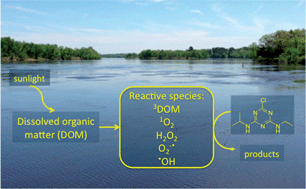
Environ. Sci.: Processes Impacts, 2014,16, 628-653
https://doi.org/10.1039/C3EM00549F
Kinetics of heterogeneous reactions of ozone with representative PAHs and an alkene at the air–ice interface at 258 and 188 K
The ozonation rates of representative PAHs and alkenes at the air–ice interface were shown to increase with decreasing temperature.
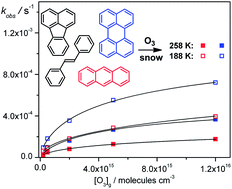
Environ. Sci.: Processes Impacts, 2014,16, 770-776
https://doi.org/10.1039/C3EM00665D
Blending remote sensing data products to estimate photochemical production of hydrogen peroxide and superoxide in the surface ocean
A novel combination of remote sensing products is used to estimate photochemical production rates of hydrogen peroxide and superoxide in the global surface ocean.
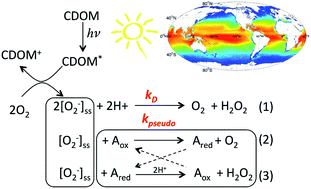
Environ. Sci.: Processes Impacts, 2014,16, 792-806
https://doi.org/10.1039/C3EM00617D
Wavelength and temperature-dependent apparent quantum yields for photochemical formation of hydrogen peroxide in seawater
Wavelength, temperature and light-dose dependent hydrogen peroxide photoproduction quantum yields were determined in subtropical, temperate and polar marine waters.
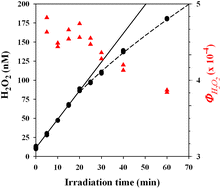
Environ. Sci.: Processes Impacts, 2014,16, 777-791
https://doi.org/10.1039/C4EM00036F
Photo-reactivity of natural dissolved organic matter from fresh to marine waters in the Florida Everglades, USA
Photo-production of reactive species by NOM in the Florida Everglades was examined across salinity gradients and coupled with PARAFAC analysis.

Environ. Sci.: Processes Impacts, 2014,16, 866-878
https://doi.org/10.1039/C3EM00591G
Insights into the complete and partial photooxidation of black carbon in surface waters
Dissolved black carbon is more susceptible to photooxidation than particulate black carbon, and partial photooxidation of dissolved black carbon is a more important degradation pathway than complete photooxidation.
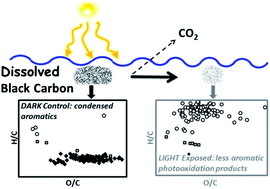
Environ. Sci.: Processes Impacts, 2014,16, 721-731
https://doi.org/10.1039/C3EM00597F
Estimating hydroxyl radical photochemical formation rates in natural waters during long-term laboratory irradiation experiments
This study showed that hydroxyl radical (˙OH) production during long-term irradiation experiments is most accurately measured using instantaneous rates.

Environ. Sci.: Processes Impacts, 2014,16, 757-763
https://doi.org/10.1039/C3EM00587A
Degradation of organic pollutants in/on snow and ice by singlet molecular oxygen (1O*2) and an organic triplet excited state
Lifetimes of pollutants are reduced on ice due to enhanced 1O*2 and the excited state triplet of the organic sensitizer.
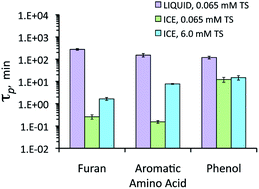
Environ. Sci.: Processes Impacts, 2014,16, 748-756
https://doi.org/10.1039/C3EM00565H
Evidence for dissolved organic matter as the primary source and sink of photochemically produced hydroxyl radical in arctic surface waters
Photochemical hydroxyl radical formation decreases with increasing water residence time in a system of lakes connected by streams in the Arctic.
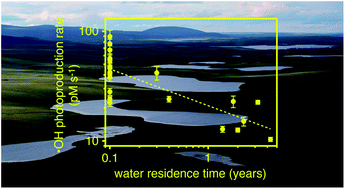
Environ. Sci.: Processes Impacts, 2014,16, 807-822
https://doi.org/10.1039/C3EM00596H
Photometric hydroxyl radical scavenging analysis of standard natural organic matter isolates
Hydroxyl radical (˙OH) scavenging reaction rate constants of standard natural organic matter (NOM) isolates (k˙OH,NOM) were measured with a rapid background scavenging method.
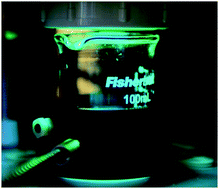
Environ. Sci.: Processes Impacts, 2014,16, 764-769
https://doi.org/10.1039/C3EM00663H
Direct photodegradation of lamotrigine (an antiepileptic) in simulated sunlight – pH influenced rates and products
In simulated sunlight, pH influenced the direct photodegradation of lamotrigine, an antiepileptic drug recently detected in surface and drinking waters, producing different degradation rates, quantum yields, pathways, and photoproducts.
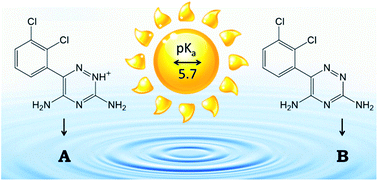
Environ. Sci.: Processes Impacts, 2014,16, 848-857
https://doi.org/10.1039/C3EM00581J
Photodegradation routes of the herbicide bromoxynil in solution and sorbed on silica nanoparticles
We compare the kinetics of the main photodegradation pathways of bromoxynil free and bonded to silica nanoparticles in simulated natural waters.
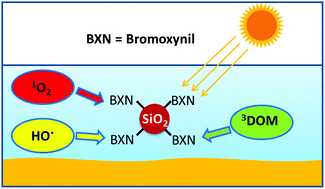
Environ. Sci.: Processes Impacts, 2014,16, 858-865
https://doi.org/10.1039/C3EM00576C
Organic matrix effects on the formation of light-absorbing compounds from α-dicarbonyls in aqueous salt solution
Aqueous-phase reactions of organic compounds are of general importance in environmental systems.
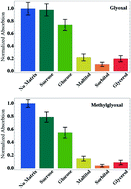
Environ. Sci.: Processes Impacts, 2014,16, 741-747
https://doi.org/10.1039/C3EM00579H
Photoreactivity of the fungicide chlorothalonil in aqueous medium
In water, chlorothalonil undergoes photolysis via the triplet excited state and generates singlet oxygen with high quantum yield.
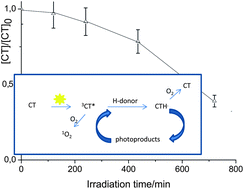
Environ. Sci.: Processes Impacts, 2014,16, 839-847
https://doi.org/10.1039/C3EM00537B
APEX (Aqueous Photochemistry of Environmentally occurring Xenobiotics): a free software tool to predict the kinetics of photochemical processes in surface waters
The APEX software predicts the photochemical transformation kinetics of xenobiotics in surface waters as a function of photoreactivity parameters, water chemistry and water depth.
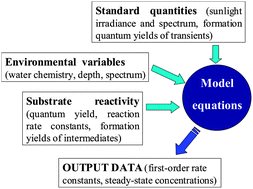
Environ. Sci.: Processes Impacts, 2014,16, 732-740
https://doi.org/10.1039/C3EM00541K
One electron oxidation potential as a predictor of rate constants of N-containing compounds with carbonate radical and triplet excited state organic matter
One electron oxidation potential predicts reaction rate constants of two reactive intermediates, carbonate radical and triplet state excited organic matter.
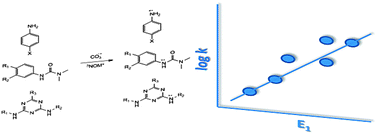
Environ. Sci.: Processes Impacts, 2014,16, 832-838
https://doi.org/10.1039/C3EM00479A
Chlorpropham and phenisopham: phototransformation and ecotoxicity of carbamates in the aquatic environment
In this study, a comparison of two carbamic pesticides, chlorpropham and phenisopham, was carried out in terms of both photodegradability and ecotoxicity.

Environ. Sci.: Processes Impacts, 2014,16, 823-831
https://doi.org/10.1039/C3EM00400G
About this collection
Guest editor Kristopher McNeill presents this themed issue on aquatic photochemistry. The research articles and critical reviews found in this collection cover a diverse range of topics and sub-disciplines within environmental science, representing both the excitement and breadth of current aquatic photochemical research. From the field to the laboratory to the silicon computer chip, from lakes and rivers to atmospheric aerosols, from anthropogenic chemicals to natural organic matter, scientists are confronting challenges and demonstrating how diverse and strong the field of aquatic photochemistry truly is.